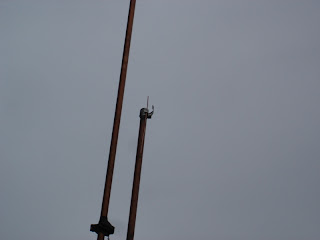My buddy gave me a foot control trolling motor that he wasn't using anymore. Of course, it wasn't something that I could just bolt on. Never seems to work that way around here. So I ran over to the local farm supply and bought a sheet of aluminum and a couple pieces of aluminum channel. Then I fabricated a box with them and a piece of treated 4x4 that was laying in the junk pile behind the chicken coop. I ran some wiring down to a battery that I built into the front of the boat and suddenly I had a trolling motor for a grand total cost of about $50. If I didn't have the basic skills to do this myself I couldn't have afforded it.
We burn our trash around here, at least the trash we can't recycle. Mostly it's paper and some small bits and pieces of the various wrappers that go around everything we buy. We've been using a trash barrel for the last couple of years and like all trash barrels it finally burned through. So we needed to get another.
I was going to just buy another barrel when it occurred to me that I could probably build something that would be safer, more efficient and would also last for years. So I went over to Haslag, the local steel yard and bought some material. I worked up an idea in my head on the drive over and had them cut the stuff to the sizes I needed. When I got home my buddy Rick came over and we built a trash burner designed like a woodstove.
This mindset of mine, build it myself to save money, has come in real handy with the ham radio hobby. In fact, it seems the entire hobby is built around the DIY ethic. Even the radios come with detailed schematics and the expectation...no more than an expectation, a design demand....that they be opened up and worked on by the consumer. What else do you buy today that wants you to get inside and mess around. Hell, you can't even take the tag off a pillow!
The natural place to tinker and save some money in the ham world is with antennas. These buggers can get expensive if you buy them already built. But, with a little investment in some tools, you can build them yourself. It's not simple, yet it is. There's plenty of math and electrical theory to learn but that's part of the fun. The resource pool is deep so getting the info isn't difficult. A great place to start is the ARRL and their Handbook and Antenna book. Both are essential
.

Then just leap into action! Expect failure. That's part of the fun, too. But with every failure comes learning and experience.
This is my first homebrewed antenna, a 2 meter J-Pole. It's built out of 1/2" copper pipe, the same stuff we use for plumbing, and some connectors. There's a bit of math involved. The wavelength has to be converted to inches so that the length of the various pieces can be determined. You can find this information at websites like Ham Universe.
I built this antenna a few weeks ago and it worked pretty well, at least on the upper part of the 2 meter band. But the SWR (standing wave ratio) was unacceptably high from around 145.50 on down. I knew from my research into the topic that this probably meant that the 1/4 wave section of the antenna was a bit short. That's the short piece sticking up on the right side.
The question was, how to lengthen it?
Using the knowledge I've gained since I built this I came up with a plan. And here it is:
I took a piece of 12 gauge Romex and stripped the ground out of it. A quick trip to the hardware store and I returned home with a simple hose clamp. I clamped the wire to the pipe, leaving about an inch and a half sticking up. I hooked up the antenna analyzer and saw an immediate improvement, with the SWR falling all across the band. Figuring I could get it a little better a I trimmed about a 1/4" off the wire and it dropped some more. Another 1/4" trim and I had it.
I've gotten plenty of signal strength reports since then telling me just how well this antenna is working. I'm more than satisfied with its performance.
And I might have $10 in it. If I'd bought an antenna instead of building it I could have spent more than $50 for one that wouldn't work any better.
So being cheap, for whatever the reason, and having basic mechanical skills can make for a way more enjoyable hobby, no matter what it is. Learn to use tools. Learn how things work. And learn to do it yourself.
It used to be that everybody did their own repairs. Not so much anymore. Don't be one of those people that always needs someone else to save the day. Take up your hammer and become a DIY superhero.
It may not be as cool as leaping tall buildings in a single bound but it sure is rewarding. And it can save you a bunch of money, too. Which will make your significant other happy. And that's the greatest super power of all.





No comments:
Post a Comment